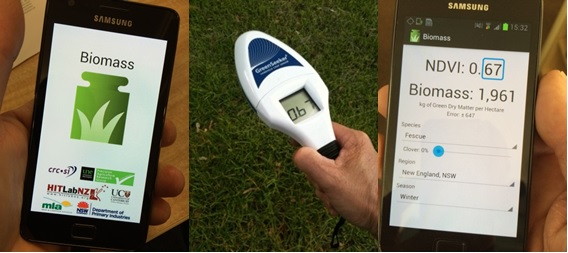Biomass Business II
Biomass Business II — Tools for Real Time Biomass Estimation in Pastures

Funding body
Cooperative Research Centre for Spatial Information (CRCSI) and Meat Livestock Australia
Overview of project and proposed outcomes
The Biomass Business II project evaluated the potential for an active NDVI sensor (which measures plant ‘greenness’) to provide estimates of pasture biomass. The project (funded by MLA and CRCSI) was focussed in the high rainfall zone of south–eastern Australia and developed pasture biomass calibrations based on the sensor readings and pasture height. The calibrations are available to producers via the ‘Biomass’ app. The app also allows producers to develop their own calibrations. The app is available on android, with development being undertaken to make it also be available on iOS.
Regional calibrations on the app are provided for: temperate grasses, lucerne and white clover on the northern tablelands, NSW; tall fescue and lucerne on the northern slopes, NSW; phalaris and perennial ryegrass in north central and south western Victoria, perennial ryegrass and white clover in the Midlands in Tasmania. In addition, custom calibrations based on smaller sample numbers are provided for mixed pastures in central west NSW, and perennial ryegrass and clover in Arthur River, WA.
The project provided a proof-of-concept that AOS can be used to help provide objective estimates of green pasture biomass. The NDVI can, however, ‘saturate’ as increasing leaf matter below the canopy is not detected. NDVI was also of little use on fertile pastures at many of the sites in Victorian where high NDVI readings were measured on short pasture, resulting in only a narrow NDVI range. These limitations mean that height is generally needed for many of the calibrations.
Research was undertaken on the UNE farms at Armidale, and with Participatory Research Groups (PRGs) at Kingstown (Northern slopes, NSW), Guyra and Walcha (New England Tablelands, NSW), Hamilton, Rokewood, Shelford and Mansfield (Victoria), and Launceston (Midlands, Tasmania), Forbes (central west NSW) and Arthur River (Western Australia). Six pasture types were assessed through the growing season over three years – tall fescue, phalaris, perennial ryegrass, white clover, lucerne and cocksfoot. The PRG sites were commonly mixed swards. 210 sets of pasture cuts were collected throughout the growing season over 3 years.
Green dry matter (GDM) was regressed against NDVI and height for each set of pasture cuts, and for pooled regional data. Eighty two percent of the individual campaigns had strong correlations (r2 > 0.70) between GDM and height or NDVI. The regional calibrations based on pooled data had r2 of 0.66 – 0.88, with coefficient of variation of 22-38% for temperate grasses, 26-31% for white clover, and 26-43% for lucerne.
Funders: CRC SI, MLA
Collaborators: UNE, University of Canterbury
Project participants
University of New England, University of Canterbury (NZ), Sundown Pastoral Company, Twynam Agricultural Group and New South Wales Department of Primary Industries
Key contact person details
Dr Andrew Robson, UNE-PARG 0417 322137, arobson7@une.edu.au.

